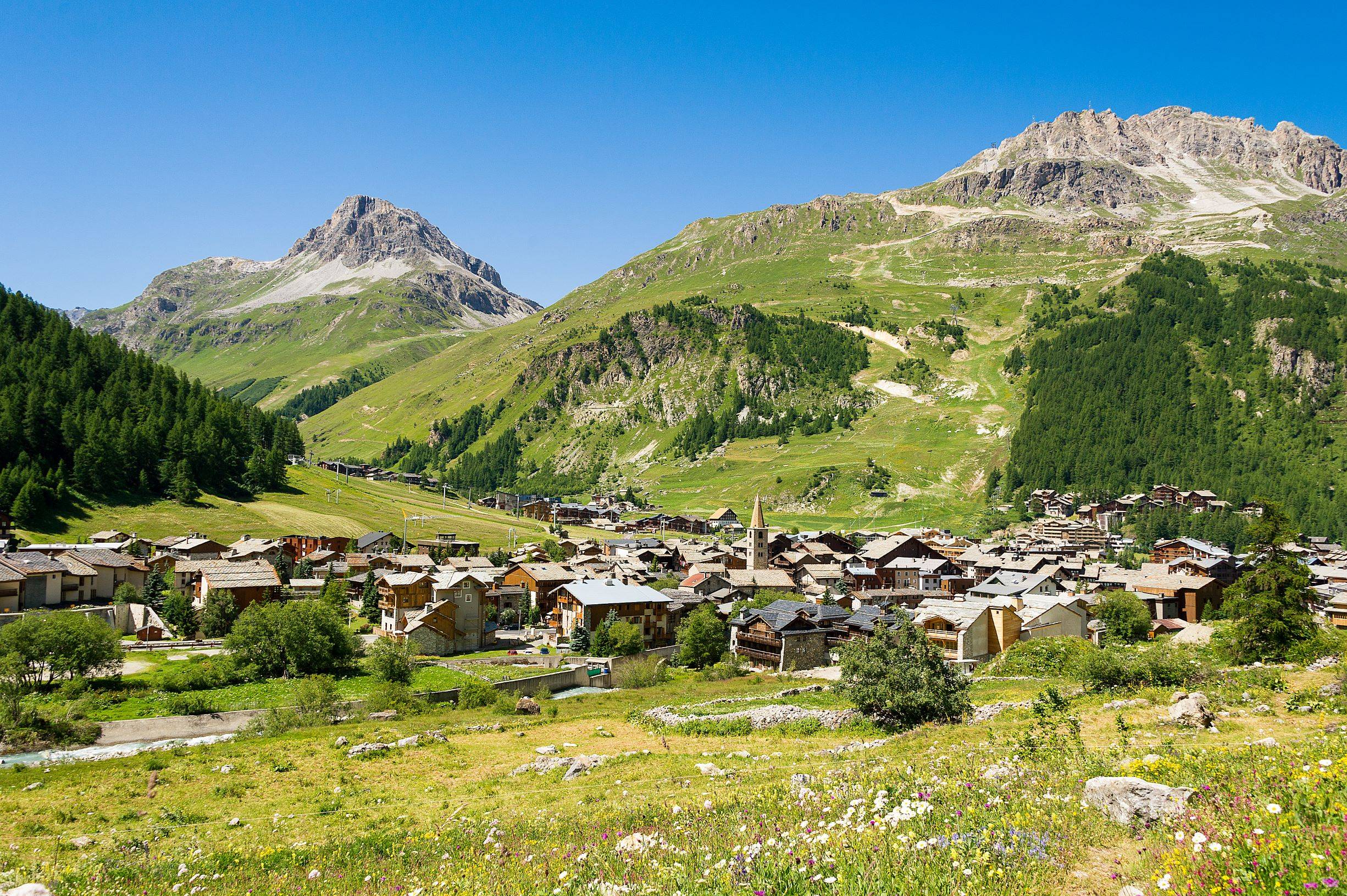
4-At the gateway of Vanoise, between mountain pastures and chapels
Woodland trail : 7 km
Path : 2 km
2 difficult stretches
This trail gives you an insight into the rich religious past of Val d'Isère and its hamlets, through the seven chapels that you'll pass along the way. There used to be more, but many have since disappeared, either owing to the wrath of the mountain (avalanches, floods) or for want of funds to maintain them. Le Manchet hamlet still harbours a few ruins that have survived over the centuries.
Setting off from the resort of Val d'Isère, part of the circular route runs along lovely green sections, between woodland and the Isère riverbanks. Vanoise National Park is just beyond the mountain pastures you'll be riding through. On the final leg, by Le Fornet, you'll cycle over a magnificent bridge straddling the rushing River Isère.
Description
Follow the green waymarks: les 7 Chapelles.
E-bike rental shops and e-bike charging stations:
Val E-Bike
Val d'Isère Tourisme
Place Jacques Mouflier
73155 Val d'Isère
Val E-Bike
Parc des Sports du Manchet
73155 Val d'Isère
+33 (0)4 79 06 06 60
- Departure : Val d'Isère Tourisme, place Jacques Mouflier, 73155 Val d'Isère
- Arrival : Val d'Isère Tourisme, place Jacques Mouflier, 73155 Val d'Isère
- Towns crossed : VAL D'ISERE
Forecast
Altimetric profile
Sensitive areas
Alpine ibex - winter
- Impacted practices:
- Aerial, Land, Vertical
- Sensitivity periods:
- JanFebMarDec
- Contact:
Parc national de la Vanoise - Elodie Antoine -
elodie.antoine@vanoise-parcnational.fr
04 79 06 03 15
Bearded vulture
- Impacted practices:
- Aerial, , Land, Vertical
- Sensitivity periods:
- JanFebMarAprMayJunJulAugNovDec
- Contact:
Parc national de la Vanoise
Jérôme CAVAILHES - 06.89.17.78.02 jerome.cavailhes@vanoise-parcnational.fr
Recommandations
If in doubt, you can take an introductory lesson in how to ride an electric bike with an instructor.
If you see a herd ahead, slow down and go round it. If there is a patou, a guard dog, climb down from your bike and walk, pushing it alongside you. Avoid making any sudden or aggressive gestures towards the dog and move away from the herd slowly and calmly. The dog will only be checking that you do not pose a threat to its herd. Respect the parkland and close gates behind you after you've gone through them.
The mountain is living, please respect it by staying on the paths and tracks.
Information desks
Transport
Find out more at: www.oui.sncf.com
You can then get a coach to Val d'Isère Bus Station.
Find out more at: https://vente-bellesavoieexpress.fr/
Have you also thought about car-sharing?
Access and parking
Parking :
Accessibility
- Emergency number :
- 114
10 points of interest

Le village de Val d'Isère - Andy Parant  History
HistoryVal d'Isère village
It all began back in 1888 when the first hotel opened in Val d'Isère. Skiing became fashionable from the 1930s, and Val d'Isère soon established itself as a leading destination (the ski school opened, its first ski lift opened and the Col de l'Iseran mountain pass road opened). Winter sports really took off after World War II and Val d’Isère became a world-class resort thanks to its unique ski area and the authentic charm of its village. In 1955 it launched the Criterium de la Première Neige, a mythical downhill ski race, followed by other renowned competitions. The traditional Savoyard architecture showcases local materials: stone, timber, metal and lauze slate. Although timber chalets are still the best-known mountain house, the architecture in Val d’Isère also features a range of other types. Most chalets in Val d'Isère have been built in keeping with the traditional style and the different hamlets across the resort (Le Joseray, Le Fornet, Le Crêt, etc.) all harbour architectural secrets that are well worth uncovering on outings.
Guided tours of the resort are organised by the Tourist Office.
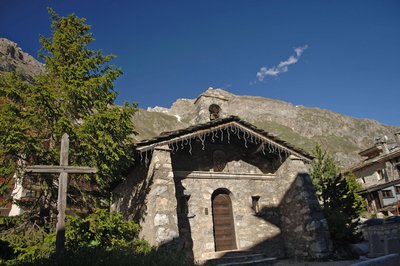
La chapelle Saint-Germain de la Daille - Val d'Isère Tourisme  Small heritage
Small heritageSaint-Germain de la Daille Chapel
Notice how the bell tower of this chapel doesn't have a bell, and eaves walls have been developed, supporting a roof overhang. As an improvised shelter, this protects passers-by from the wind and rain. In the recess above the entrance doorway: there is a figure of St Germanus! This is a recent chapel, since it was built in 1939 on a plot of land donated in 1936 by Clotilde Boch (née André) and blessed by the bishop on 31 July: the Patron Saint's feast day.
Who is St Germanus? Legend has it that he destroyed wild beasts and halted the avalanches that ravaged the region of Séez. According to Arnold Van Gennep, "in our regions, he is regarded as the patron saint of travellers". And what a fitting guardian for La Daille he made! For we might well imagine travellers of yesteryear, before venturing into the formidable gorges of ice (by which La Daille gorges are also known), offering up a final prayer to St Germanus, calling for his protection.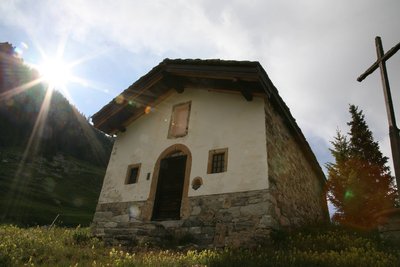
La chapelle Notre-Dame-des-Neiges du Joseray - Val d'Isère Tourisme  Small heritage
Small heritageNotre-Dame-des-Neiges du Joseray Chapel
This chapel in Le Joseray, named "our Lady of the Snows", overlooks Le Manchet Valley. Mentioned as far back as 1633, firstly under the name St Michel and then, in 1790, under the name Our Lady of Compassion, it is now referred to as Our Lady of the Snows. In our mountains, whenever the Virgin or Our Lady is described as being "of the Snows", she is called upon to protect from the snow or ward off avalanches. On 5 August, during the Saint’s feast day, Mass used to be held in the chapel after a procession had taken place. In May, Le Joseray’s procession marked the end of the Rogation Days, which were a period when prayers were offered for God’s attention on the fields and harvests, to protect them from bad weather and insects. The fifth Sunday after Easter was Rogation Sunday, after which the “Grand Tour” would begin: Monday in Le Fornet, Tuesday in La Daille. On Wednesday, the third and final day of the Rogation ceremonies, the procession would leave the church while the cleric rang the bells until the parishioners arrived in Le Joseray. At each cross or crossroads, the procession would stop for the vicar to bless the fields. Chapels and churches dedicated to St Michael all feature the same characteristics: they stand out from afar as they are always built on a rocky spur or hillock, overlooking the landscape and reminding us mere mortals that, when the time of death comes, our deeds will be judged! In many places, the livestock would be brought back down from the high mountain pastures on St Michael’s Day: this was known as the démontagnée date. From the early Middle Ages, St Michael’s Day was also an important legal date: payments were due and contracts were renewed. This chapel is the largest of all the rural chapels in Val d’Isère and has a long nave with a barrel vault, culminating in a plain rectangular apse.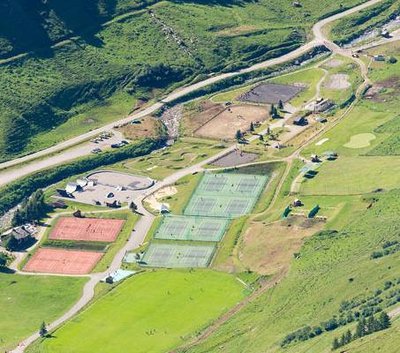
Le parc des sport du Manchet - CCHT  Viewpoint
ViewpointLe Manchet Sports Park
At the gateway to Vanoise National Park, in an unspoilt, open valley, come and have fun doing some of the wide array of sports and activities organised at Le Manchet Sports Park.
Horse riding, fitness, football, tennis, skatepark, yoga, children's games… whether you're here with your family or friends, there'll be something for all of you to enjoy!
There's also a bar & restaurant on-site if you're feeling peckish!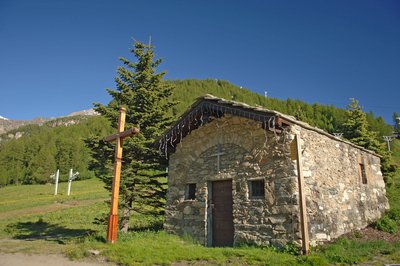
La chapelle Saint-Jean-des-Prés - Val d'Isère Tourisme  Small heritage
Small heritageSaint-Jean-des-Prés Chapel
You’ll be able to recognise St Jean’s Chapel by the larch mission cross, erected in 1847. In the olden days, there was once a built-up spur behind the chapel (structure to protect against avalanches that could come down from Solaise via the Combe Martin). On striking the spur, they would split, lose speed and thus slow their destructive force. Built some 300m south of the church, the purpose of this chapel was to protect the village and its residents from avalanches. In 1790, four Masses, costing 12 sols (shillings) each, were celebrated a year. They were financed by an émigré who had moved to Val d’Isère, a merchant from Parma: Amédée Thovex. A procession would set off from the church with the reliquary in honour of St Innocent (21 July), the second patron saint of the Val church. With the reliquary perched on the shoulders of the male church members, banners, female church members covered in a white veil, vicars and clerics followed by believers would form this long procession that would head out along the road to Le Laisinant. On leaving the village, they would turn towards Le Rogoney to make their way back to St Jean’s Chapel where a blessing would take place before returning to the village: this was a day of celebration!
Who was St John? A prominent figure of the New Testament, who can be found in a great many scenes, John, beloved disciple of Christ, has always been depicted in the iconography of the Western Church with young, and even effeminate features at times.
La chapelle Saint-Barthélémy du Laisinant - Val d'Isère Tourisme  Small heritage
Small heritageSaint-Barthélémy du Laisinant Chapel
Built prior to 1633, during a pastoral visit, the bishop ordered the villagers to take care of the building by closing it to stop animals from straying inside! Thanks to the proceeds from a meadow behind the chapel, Anne-Marie Guiller enabled Mass to be held on the feast day of the patron saint. In the chapel, there used to be a painting of the Virgin and Child which, after being restored, has been placed on the Epistle wall in the church chancel. St Bartholomew is shown with his curved knife; the Virgin, breastfeeding, can be seen to the right in the middle ground.
Who was St Bartholomew? The Patron Saint of butchers, tanners and binders, St Bartholomew is also revered by farmers. His feast day is 24 August. In iconography, Bartholomew carries his own skin as he was flayed alive. Sometimes he is depicted holding the large knife that was used for this torture. According to Arnold Van Gennep, "St Bartholomew is a time-honoured saint in all of the dioceses in Savoie."
L'oratoire du Fornet - Val d'Isère jadis et naguère Brigitte Alzieu  Small heritage
Small heritageLe Fornet oratory
There have been four different chapels in Le Fornet down the ages, each one having been swept away by avalanches. After the avalanche in February 1767, the villagers wanted to take their time thinking carefully about where the best place would be to build the their chapel dedicated to St Mary Magdalene. They finally decided to build a little oratory on the ruins of the previous chapel and, despite the fickle weather, it is still standing to this day! The date 1767 is inscribed on the door under the roof eaves.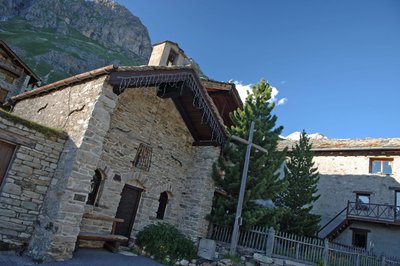
La chapelle Sainte-Marie-Madeleine du Fornet - Val d'Isère Tourisme  Small heritage
Small heritageSainte-Marie-Madeleine du Fornet Chapel
The chapels in Le Fornet have seen a fair bit of change over the centuries… that’s because of the avalanches. There have been four in all, dedicated to St Mary Magdalene each time. The first chapel was built between 1600 and 1630 near the larch forest to protect the village from avalanches. The present-day chapel was built in 1890, thanks to funds from Joachim Bonnevie. Above the entrance doorway, you can see the statuette of the Patron Saint in the recess. This was sculpted very recently as the original was stolen in the 1980s, along with many other religious artefacts. Up until the 1990s, on St Mary Magdalene’s Day, the vicar would come and bless the houses, then hold Mass in the chapel for the local congregation.
Who was Mary Magdalene?
According to the New Testament, Jesus cast out seven demons from Mary Magdalene. She went on to become one of his disciples - perhaps the most important. She was the first to witness Jesus’ Resurrection, which makes her very important. She is also the woman who features most prominently in the New Testament. Mary Magdalene weeps, as she does not understand what the angels are saying, it’s so unimaginable. That’s when Christ appears and speaks to her. He tells her that he is going to ascend to be with God and that she must tell the other disciples. 22 July is her feast day.
Why does Mary Magdalene have a special place in Le Fornet?
At this exact spot, water flows at the bottom of the gorge. It would have been difficult to access the River Isère if there was a fire. So the locals relied on Mary Magdalene’s tears to put out any fire.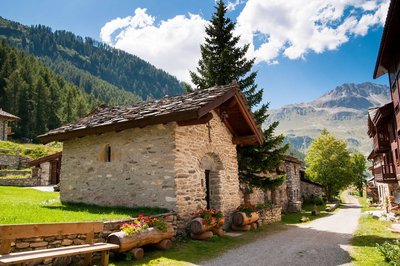
La chapelle Sainte-Lucie aux Branges - Val d'Isère Tourisme  Small heritage
Small heritageSainte-Lucie aux Branges Chapel
At the time it was mentioned during the pastoral visit in 1633, this chapel was dedicated to St Francis of Assisi. The painting showing the stigmata of St Francis now hangs in St Roch’s Chapel. In the 18th century, it would be dedicated to St Lucy. In 1790, Mass was celebrated there for her feast day. The chapel was restored by Guy Turbil, who owned the house next door, in 1971. There were once several houses in the hamlet or village of Les Branges. This name refers to larch trees in local dialect.
Who is St Lucy?
Born into a very wealthy noble family from Syracuse, Lucy (who died between 303 and 310) lived with her mother Eutychia and venerated St Agatha. As her mother suffered from an inflammatory bowel syndrome and blood loss, one day Lucy decided to take her to Agatha’s tomb, in Catania, to ask for healing. The next day, Eutychia recovered. Following this healing, Lucy asked her mother’s permission to distribute to the poor everything that her father had left her. Both women then began giving all that they owned to the poor, a little each day. But Eutychia had promised Lucy’s hand in marriage to a young man who flew into a fit of rage when he heard that his fiancée wished to remain a virgin and was selling her fortune, which he had his eyes on, to give to the poor. So he denounced her to the Consul Pascasius, as an enemy of the deities of the Roman Empire. Refusing to give up her Christian faith, Lucy was sent to a brothel then martyred. Her name comes from the Latin word lux (which means light), and that is why she is associated with many festivals of light.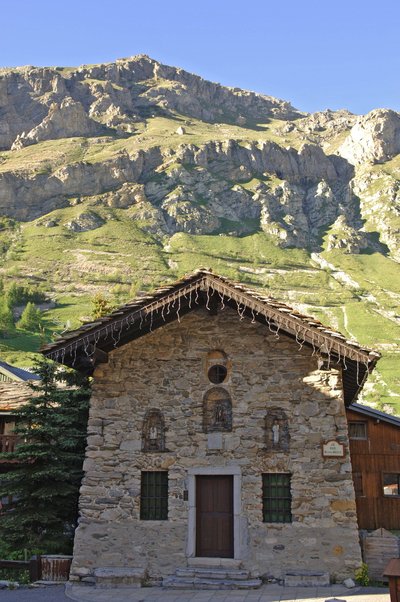
La chapelle Saint Roch - Val d'Isère Tourisme  Small heritage
Small heritageSt Roch’s Chapel
St Roch’s Chapel stands on the square, a stone’s throw from the church. For a long time, the headrace that brought water to the adjacent mill flowed right in front of the chapel! (You can still see a millstone standing on the side). St Roch, Joan of Arc and the vicar of Ars can be seen in the recesses (the old statues were stolen). This chapel is mentioned during the pastoral visit in 1633. In 1790, a lawyer in Turin by the name of Boch gave a donation to enable 51 services to be held a year, i.e. one every Friday (what did he fear for the community and for himself we might wonder?). Nowadays, this chapel is still used as a chapel of rest.
Who was St Roch?
St Roch’s feast day is celebrated on 16 August. He was a hermit who spent his time embarking on pilgrimages. Often associated with St Sebastian, St Roch is invoked against plague. Veneration of him began to spread across Savoie in the mid 15th century, swiftly gaining ground through the 16th and 17th centuries, before almost completely disappearing in the 18th century. Plague was a terrible disease. Its pandemics took a devastating toll on populations. Yersin’s bacillus, the vector of the disease, was not identified until the 19th century. Rats carried the bacillus, and fleas, moving from the rats to humans, contaminated the population. In our mountain communities, which were crawling with hawkers, mule-drivers, merchants and smugglers, it’s hardly surprising that the disease often blighted the local populations. All it took was for a flea carrying the bacillus to jump inside the lapel of a cloak and the disease was there…
